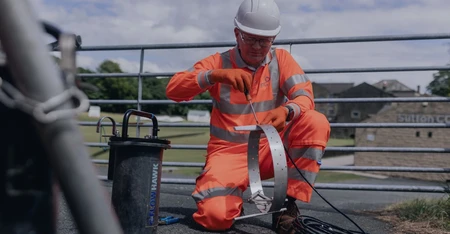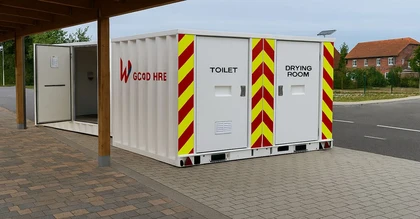Manage and mitigate the risks linked to hazardous materials through hazmat test services. Create a safer environment for your business.
Hazardous materials (Hazmat test) are classified as those materials and substances, which due to their presence in a particular building or area; pose a potential threat to the health and safety of staff and members of the public.
Their presence may be due to their use in the original construction and subsequent use of the building, or may alternatively be due to introduction at a later date from activities such as waste tipping, manufacture or material storage.
We can carry out surveys which concentrate on those hazardous materials present on site which pose a risk to the health and safety of staff engaged in the works or members of the public.
Common Hazardous Materials include:
- Discarded medical supplies, hypodermic syringes/other drug related paraphernalia
- Lead and lead oxides in paint coatings – may also include be cadmium and chromium in certain cases
- Heavy metals in old wall coatings
- Chemicals, paints, oils and other substances left in within buildings
- Dusts, debris and other solid substances within the building/site which may be hazardous to health
- Polychlorinated biphenyls (PCBs) – transformer oils, capacitors, oil filled cables
- Anthrax (animal by-products/hair within building insulation/plaster)
- Biohazards – moulds, fungi, sewage, airborne bacteria etc
- Man Made Mineral Fibre (MMMF) present in insulation materials
- Stagnant water present on site – leaking pipes, water ingress, water in tanks, heating/boiler systems
- Asbestos
Analysis of suspected hazardous materials is carried out at our in-house Advanced Chemistry & Research laboratories, using a variety of techniques including GC-MS, FTIR, ICP-OES and Scanning Electron Microscopy. Once complete, comprehensive reports are produced detailing the extent of the contamination, with recommended remedial actions / disposal considerations.
What is classed as hazmat?
Hazardous materials, or Hazmat, are systematically classified to ensure safety during handling, transportation, and storage. The classes include:
- Explosives: These can combust or detonate, examples include fireworks, flares, and TNT.
- Gases: Flammable, non-flammable, and toxic gases like propane, hydrogen, and methane belong here.
- Flammable Liquids: This class includes gasoline, ethanol, and acetone.
- Flammable Solids and Substances: Substances that can ignite easily and continue to burn or smolder.
- Oxidizing Substances and Organic Peroxides: These can cause or contribute Hazardous materials, or Hazmat, are systematically classified to ensure safety during handling, transportation, and storage. The classes include:
- Explosives: These can combust or detonate, examples include fireworks, flares, and TNT.
- Gases: Flammable, non-flammable, and toxic gases like propane, hydrogen, and methane belong here.
- Flammable Liquids: This class includes gasoline, ethanol, and acetone.
- Flammable Solids and Substances: Substances that can ignite easily and continue to burn or smolder.
- Oxidizing Substances and Organic Peroxides: These can cause or contribute to combustion of other materials
- Toxic and Infectious Substances: Materials that can cause harm or death when swallowed, inhaled, or come in contact with skin.
- Radioactive Materials: Substances that emit ionizing radiation.
- Corrosive Substances: These can cause severe damage to living tissue, other materials, or the environment.
- Miscellaneous Dangerous Substances: This category includes substances not covered by other classes but that pose a risk during transportation.
Class 9 Hazmat
The Class 9 Hazmat category includes miscellaneous dangerous substances and articles that don't fit into the other eight classes. This category is notably used for lithium batteries, which are increasingly prevalent due to their usage in modern technology.
Like all Hazmat, Class 9 items must meet certain criteria stipulated in the UN Recommendations on the Transport of Dangerous Goods, including passing specific tests.
Despite their classification as hazardous, Class 9 substances do not require a placard for domestic transportation within the United States. However, bulk packaging containing Class 9 Hazmat must be clearly marked with the appropriate identification number, either on a Class 9 placard, an orange panel, or a white panel.
Understanding the specifics of Class 9 Hazmat is crucial for those involved in their transportation to ensure compliance with regulations and avoid potential safety risks.
What are the 3 major types of hazmat?
Hazmat, short for hazardous materials, can be categorized into three major types based on their properties and dangers:
Mixed Radiological and Hazardous Wastes: These are wastes that contain both radiological and hazardous substances, posing dual threats. These substances can come from various sources such as nuclear power plants, research laboratories, and medical facilities.
Listed Wastes: These are specific types of waste that are listed by the Environmental Protection Agency (EPA). They fall under the F, K, P, or U lists, each representing different types of hazardous waste sources and categories.
Characteristic Wastes: These are wastes that possess certain characteristics making them hazardous by nature. These characteristics can include but are not limited to, ignitability, corrosivity, reactivity, and toxicity.
Each of these major types of Hazmat carries its own risks and requires specific handling, transportation, and disposal procedures to ensure safety and environmental protection.
Who uses hazmat?
The use of hazardous materials (Hazmat) spans across various sectors and roles.
Industry and Manufacturing: Many industries, such as chemical, pharmaceutical, and oil & gas, use hazardous materials in their production processes. These substances are also used in construction and agriculture.
Transportation and Logistics: Companies that transport dangerous goods, like DHL Express, need to handle Hazmat appropriately to ensure safety and compliance with regulations.
Healthcare Sector: Certain healthcare processes involve the use of hazardous substances, including disinfectants, sterilant, and hazardous drugs.
Emergency Response Teams: First responders, such as firefighters and HAZMAT response units, regularly handle hazardous materials during emergencies.
Waste Management: Hazmat suits are commonly used in waste disposal areas, including city landfills and chemical waste storage facilities, offering protection against semi-hazardous chemicals and dust.
Research Laboratories: Scientists and researchers often use hazardous materials in their experiments, requiring careful handling and disposal.
Government Agencies: Certain government entities, like the Environmental Protection Agency and Health Administration, deal with Hazmat in their roles of regulation, inspection, and response to hazardous incidents.
Want to find out more about SOCOTEC's Environmental Monitoring and Consultancy services?
You might also be interested in:

SOCOTEC UK & Ireland partners with Mesothelioma UK

SOCOTEC UK and Ireland Celebrates Double Nomination at Environmental Monitoring Awards

Summer Environmental Conference 2025

SOCOTEC UK Partners with Applied Genomics to Introduce Environmental DNA Analysis Suite

SOCOTEC ACQUIRES ASPECT LAND & HYDROGRAPHIC SURVEYS LTD, STRENGTHENING ITS SPECIALIST SURVEYING SERVICES AND ENVIRONMENTAL PORTFOLIO

SOCOTEC UK Proudly Supports Portgordon Community Trust with Vital Legionella Risk Assessment





